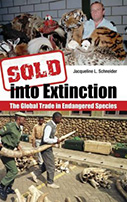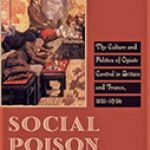Sold Into Extinction: The Global Trade in Endangered Species

Author: Jacqueline L. Schneider
Publisher: Santa Barbara, CA: Praeger, 2012. 252p.
Reviewer: AM Lemieux | July 2014
Considered to be one of the largest black markets in the world, the illegal wildlife trade has garnered a great deal of attention from the media, public officials, and academia in recent years. Most see the trade as a criminal enterprise that poses a serious and direct threat to biodiversity. Moreover, the massive profits derived from wildlife trafficking have enticed a wide variety of actors to become involved; from impoverished villagers to international diplomats. While the exact number is unknown, it is safe to say that thousands of plant and animal species are harvested and subsequently sold each year. In some cases, locals provide supply for local demand; in others, local supply is used to satisfy international demand. Despite the criminal nature, global reach and long history of wildlife trafficking, the vast majority of academic studies and prevention efforts have not been the work of criminologists. Instead, the expertise in this area lies with conservation biologists, environmental economists and non-governmental organizations. In her book, Sold into Extinction: The Global Trade in Endangered Species, Jacqueline Schneider discusses the added value criminological theory and practice offer the study and prevention of wildlife trafficking.
The three part structure of Schneider’s book is clear and simple. Part I is comprised of four chapters that describe the ‘Framework of the Problem’, Part II contains four chapters that give ‘Examples of the Problem’, and Part III, the final chapter, suggests ‘A Way Forward’ for interdisciplinary work between conservationists and criminologists. Collectively, the three parts are meant to synthesize a broad body of literature from various disciplines.
Part I of the book provides information about legal structures governing the wildlife trade, data sources that can be used to study it, the role of organized crime groups and crime reduction strategies. The first chapter describes the potential for criminological theory and practice to inform and influence anti-trafficking strategies. Most importantly, Schneider identifies the market reduction approach and situational crime prevention as viable options for reducing opportunities for the illegal harvest and sale of endangered species. Building from this foundation, the second and third chapters give information about sources of data typically used to study the wildlife trade as well as legislation and enforcement efforts which govern it. The final chapter of Part I discusses what is known about the involvement of organized crime groups in the wildlife trade. In short, Part I of Schneider’s book gives readers a general understanding of how the world’s wildlife trade operates and introduces prevention concepts that might be used to reduce its prevalence.
Part II of the book gives examples of how the wildlife trade is affecting various endangered species around the world. Each of the four chapters looks at a different class of species categorized as terrestrial, marine, avian or plant. Schneider uses a number of species-specific case studies to describe where market demand comes from, how supply is procured, and conservation efforts that have been used to slow illegal harvesting. Overall, the second part of the book gives very detailed information about the biological characteristics and legal protection of individual species as well as threats to the sustainability of their populations.
Part III is a single chapter which describes how the illegal wildlife trade might be curbed using the market reduction approach and situational crime prevention. It discusses the types of data needed to implement the market reduction approach and calls for the advent of systematic methods for data collection. It also draws from the twenty-five techniques of situational crime prevention to suggest potential crime reduction strategies.
In general, I believe Schneider took on an ambitious task in writing Sold into Extinction. The global trade in endangered species involves so many actors, situations and settings that summarizing this in a single book, let alone a few chapters, is nearly impossible in my opinion. To then link the trade with criminological theory and prevention strategies is again a commendable undertaking. The final product contains a great deal of background information about wildlife trafficking, the market reduction approach and situational crime prevention — making it an introductory read suitable for a broad audience.
As a reader who is well versed in the crime prevention and wildlife trafficking literature, I believe the book is well organized and gives a satisfactory overview of the topics listed above. However, I also feel Schneider missed key opportunities to link the market reduction approach and situational crime prevention to wildlife trafficking throughout the book. The introductory and concluding chapters discuss the linkage, but the remaining chapters make little reference to the subject. Indeed, Part II of the book which describes the trade of various species often reads like an encyclopedia with general facts about individual species and markets. Unfortunately, many of the facts presented are not linked to prevention strategies which left me a bit disappointed and feeling as though I was reading a literature review on separate subjects.
On the whole, I believe Schneider’s idea to link the market reduction approach and situational crime prevention to wildlife trafficking is a good one. As she notes however, these prevention strategies suggest combating very specific types of crime using detailed data about criminal events. Thus I found it a bit puzzling that the data sources described in the book were for the most part macro-level or aggregated data about the trade. These lack the specificity required to implement the market reduction approach or situational crime prevention. Although Schneider acknowledges the deficiencies of these data and correctly asserts they are not very useful for informing the crime prevention strategies she suggests, this nevertheless results in a disconnect between the book’s introduction and subsequent chapters. Put simply, because Sold into Extinction discusses wildlife trafficking using publically available data which were not collected for criminological research, Schneider is limited in her ability to link the literature review to concrete examples of how to implement crime reduction strategies.
That said, I felt Schneider underemphasized the importance of law enforcement data and was too quick to dismiss it as a ‘mystery to the public’ (pg. 16). Collaboration between law enforcement agencies and criminologists has been integral to many applications of the market reduction approach and situational crime prevention. While building partnerships to combat wildlife trafficking is hindered by the physical distance between Western academics and law enforcement operations in developing nations, such barriers can be overcome. In fact, without such collaborations the prevention strategies suggested by Schneider would not be possible. Moreover, the value of community surveys, market counts and publically available data from non-governmental organizations was underexplored in Chapter 2, ‘Data and Patterns’. These sources are commonly published in conservation biology journals and contain detailed information about hunting patterns, market volume and wildlife product use.
Regarding future data collection efforts, Schneider makes an excellent argument for standardizing the methodology used by law enforcement agencies around the world. Recognizing the limitations of current data, and the lack of international standardization, she emphasizes the value of having comparable data across the trade continuum. For international trafficking, this would help officials link offenders to one another and follow the trail of products as they move to a final destination. It would also enable cross-national comparisons for academic and policy related research. Schneider’s advocacy for this sort of data collection is warranted and an important consideration for law enforcement agencies and their partners.
In the concluding chapter of the book, Schneider proposes various ways to curtail the illegal wildlife trade using the market reduction approach and situational crime prevention. She suggests collecting Extra Routine And Systematic Opportunistic Research (E.R.A.S.O.R.) data such as structured interviews with conservation officers, local residents, or current/former poachers. Migration, nesting and foraging data could also be considered E.R.A.S.O.R. data. Combined with traditional sources of crime data, this would help identify offender motivations and the opportunity structures enabling a crime such as poaching or the subsequent sale of wildlife. Using an interagency model, structured data collection and information sharing would be invaluable for targeting multiple individuals involved in the chain of criminal events. In my opinion, Schneider should have gone into greater detail about the implementation of the market reduction approach in different settings or against different species. The section was very brief and would have benefited from the use of more examples linking the market reduction approach to the endangered species described earlier in the book.
Following her final discussion of the market reduction approach, Schneider lists various ways situational crime prevention might be implemented to discourage wildlife trafficking. Numerous examples describe interventions that increase the effort, increase the risks, decrease the rewards, reduce provocations and remove excuses associated with crime. This section is a nice introduction to the twenty five techniques of situational crime prevention and how they can be operationalized for specific criminal events. Like other portions of the book, this too would have been better with more examples relevant to the earlier chapters. Nevertheless, Schneider’s discussion of situational crime prevention techniques and wildlife trafficking is a good stepping stone for future applications and is useful for orienting non-criminologists to the subject matter.
Overall, I believe Sold into Extinction gives readers a broad overview of the illegal wildlife trade, the publically available data sources that quantify it, and the international policies which govern it. Moreover, it links prevention techniques typically aimed at traditional forms of crime to wildlife trafficking, which shows the added value criminological theory and practice could bring to conservation efforts. The book may be of interest to introductory readers, from a variety of disciplines, looking for a general synopsis of the global wildlife trade.
AM Lemieux, Researcher, Netherlands Institute for the Study of Crime and Law Enforcement


